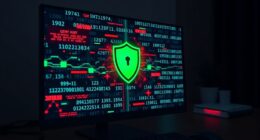Threat hunting lets you proactively find hidden cyber threats before they can inflict damage. By searching for malware, insider threats, and other suspicious activities, you can uncover anomalies that automated systems might miss. This approach enhances your overall cybersecurity posture by identifying risks early. You’ll also analyze malware patterns and monitor user behavior to catch potential threats. Continue exploring this important practice to discover how to strengthen your defenses even more.
Key Takeaways
- Threat hunting involves actively searching for hidden cyber threats, including malware and insider threats, before they can compromise systems.
- Analysts use malware analysis to understand tactics and patterns, informing defenses against similar threats in the environment.
- Insider threat monitoring focuses on unusual user behavior, helping identify potential malicious actions by employees or contractors.
- Network architecture and log auditing provide insights into vulnerabilities and anomalies, supporting a comprehensive view of security posture.
- Continuous improvement ensures threat hunting techniques adapt to evolving threats and incorporate advanced technologies like AI for better detection.

What if you could stay one step ahead of cyber threats before they even reach your systems? That’s the promise of threat hunting. By proactively searching for hidden dangers like malware and insider threats, you can substantially bolster your cybersecurity posture. Instead of waiting for alerts from your existing security tools, you take the initiative to uncover anomalies and suspicious activities that might otherwise slip through the cracks.
You start by implementing a robust malware analysis framework. This means regularly examining files and software for malicious patterns or behaviors. By analyzing malware samples, you gain insights into how they operate, which helps you identify similar threats in your environment. It’s about understanding the enemy—knowing how attackers think and what tactics they use. This knowledge allows you to create better defenses and develop strategies tailored to your organization’s unique needs.
Implementing a robust malware analysis framework empowers you to uncover hidden threats and tailor defenses to your organization’s unique challenges.
But threat hunting isn’t just about external malware; you need to keep an eye on insider threats too. Employees or contractors with malicious intent can cause just as much damage as an external hacker. By monitoring user behavior and access patterns, you can spot unusual activities that may indicate an insider threat. Are employees accessing sensitive data they don’t typically handle? Is there a sudden spike in file transfers? These red flags can help you catch potential threats before they escalate into a full-blown security incident.
You also have to be vigilant about your network architecture. Regularly auditing your systems and logs can provide valuable context. By correlating data from different sources, you can create a more all-encompassing view of your security landscape. This holistic approach allows you to identify vulnerabilities and potential entry points for attackers.
Threat hunting is an ongoing process. You need to refine your techniques continually and adapt to the evolving threat landscape. Cybercriminals are always finding new ways to exploit systems, so your methods must evolve as well. Stay informed about the latest trends in malware and insider threats to enhance your hunting strategies. Additionally, integrating AI-driven diagnostics into your threat hunting efforts can significantly improve your ability to detect and respond to potential threats swiftly.
Frequently Asked Questions
What Skills Are Essential for Effective Threat Hunters?
To be an effective threat hunter, you need strong skills in cyber forensics and anomaly detection. You should understand how to analyze data, spot unusual patterns, and investigate incidents thoroughly. Familiarizing yourself with various cybersecurity tools and techniques is vital. Additionally, you’ll benefit from having a solid foundation in network protocols and malware analysis. Continuous learning and staying updated on emerging threats will also enhance your ability to identify and mitigate risks effectively.
How Does Threat Hunting Differ From Traditional Security Measures?
Threat hunting focuses on actively seeking out threats, unlike traditional security measures that mainly react to alerts. For instance, imagine you’re analyzing network traffic and notice an unusual spike—this is anomaly detection at work. While traditional methods might flag this as an alert, you dig deeper, using threat intelligence to identify potential vulnerabilities. This proactive approach helps you uncover hidden threats before they escalate, keeping your systems more secure than relying solely on reactive measures.
What Tools Are Commonly Used in Threat Hunting?
Common tools for threat hunting include behavior analysis platforms and data visualization software. You can use behavior analysis tools to identify anomalies in user actions or network traffic, while data visualization tools help you create intuitive dashboards for better insight into potential threats. These tools allow you to spot patterns and trends, making it easier to act quickly and effectively against hidden threats. Make sure you’re familiar with the latest options available!
How Often Should Organizations Conduct Threat Hunting Activities?
You should conduct threat hunting activities regularly to stay ahead of potential threats. The ideal hunt intervals depend on your organization’s size and the volume of data, but most experts recommend at least quarterly hunts. If your environment is rapidly changing or you’ve faced recent incidents, increase your threat hunting frequency to monthly or even weekly. Consistent hunting helps you detect hidden threats before they escalate into serious issues.
What Are the Key Metrics for Measuring Threat Hunting Success?
To measure threat hunting success, think of it as a treasure hunt where each find counts. Key metrics include the number of threats detected, the time taken for incident response, and the quality of the intelligence gathered. You’ll want to track how quickly you uncover hidden threats and how effectively you respond to incidents. Just like a seasoned explorer, the more you refine your methods, the richer your rewards will be.
Conclusion
In the world of cybersecurity, you can either sit back and react to threats or take charge and hunt them down proactively. While waiting for alerts may seem safer, the thrill of uncovering hidden dangers before they strike is unmatched. By embracing threat hunting, you shift from a passive defender to an active protector, turning the tables on potential attackers. So, why not choose the exhilarating path of proactive vigilance and safeguard your digital domain with confidence?









